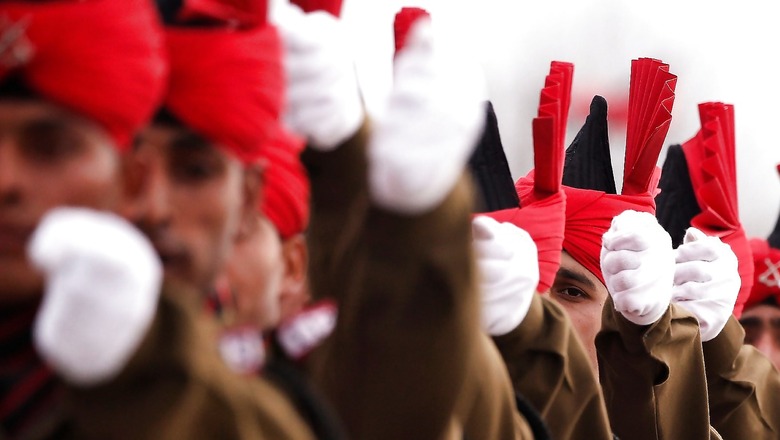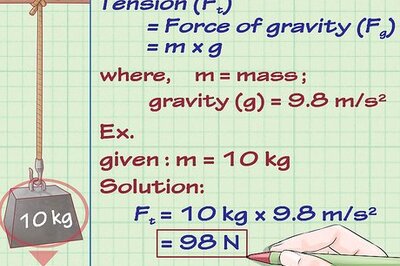
views
Agnipath is a recruitment scheme that India has rolled out for recruiting Personnel Below Officers Rank (PBOR) for the first time. However, entry into officer’s rank in terms of the Short Service Commission (SSC) has been in place for decades now.
Officers Training Academy was established to train SSC officers for the Indian Army in 1963. Air Force & Navy conduct courses in their respective academies together with their permanent commission officers.
The idea of recruiting jawans, airmen and sailors on a short-term basis, like the SSC officers, has been there for a while in Indian polity. It’s a proven system that is working in the United States where personnel are enlisted for a set period called the tour of duty (TOD).
A similar setup exists in other countries, too, including some developed nations. Therefore, statements by some veterans and party members are far from reality and to me, it appears to emanate from their deep-rooted hatred against one person/party.
I must narrate an incident which happened to me just a couple of days ago. I was kayaking and I went downstream, enamoured by nature’s beauty. I continued kayaking for about a couple of hours. Little did I realize that I travelled far from the starting point. On the way back, I had to kayak upstream, the current was strong and I wasn’t making very much headway.
Five hours from when I started, I was still a couple of kilometres to go to the starting point. Parched and drained of energy, I was finding it difficult to carry on. Being in my early 50s and retired, I can’t call myself a spring chicken. Clearly, I was struggling badly.
This is when my military training, physical strength which automatically translates into mental strength and stamina, kicked in. The last two hours were completely based on the strength provided to me by the Indian Armed Forces training. I value that physical and mental strength much more than the money, job security and pension that IAF provided me.
Coming to the Agnipath scheme, what are the tangibles and intangibles that young India would stand to gain?
1. You would have Rs 21,000 to Rs 28,000 in your pocket every month, while serving your nation, travelling places and seeing real India. All this you would be doing while serving for only nine to 10 months. Two months you get to spend at home on annual leave and, depending on the place that you serve, another 20 days you get as casual leave.
This does not include prefixed Saturday, Sunday and holidays before commencing the leave and suffixed Saturday, and Sunday and holidays as the leave ends. Depending on the place you serve, one would get to be at home for two to three months.
2. At the end of four years, when you leave, you would have a corpus of Rs 11 lakh to Rs 14 lakh, which is guaranteed, plus the savings that you would obviously have. Therefore, one can comfortably leave after four years with Rs 20 lakh in hand, tax-free. Not to mention, this is protected against inflation with the application of an annual increment.
3. When you leave, you will be called an Agniveer, and some states have already announced reservations in their state police cadre and the home ministry has announced reservations in CAPF for those who will be retiring as Agniveers.
While you are serving your nation for four years, you would be put through gruelling training. This training is not going to be any different from the training that has been provided to date. This training builds mental and physical strength and instils a certain amount of discipline, hygiene and character in the person that I explained earlier, which to me is worth more than anything in the world.
Agniveers who will come out into the civvy street after four years, would be role models in their own right, who as a teenager, would have shouldered the biggest responsibility that one can, which is to defend the nation. Such youngsters would do wonders in any field they set their foot in.
Mind you, this is not conscription where one is forced to do soldiering. This is a voluntary service in which after four years you would have (a) served (b) become a man/woman from a boy/girl (c) with a decent corpus in your pocket to start something of your own.
My simple question is how many 21-year-olds today can boast of such an advantage? Hundreds of children prepare for civil services in Delhi for four to six years, out of which very few make it and others go back home to start where they left off six years ago. Here, we would have youngsters forged in combat, ready to become anything they want, including civil servants.
Mathematics of Post-Tenure Job Security
Out of 45,000 personnel who will be recruited through this Agnipath scheme, roughly 34,000 would retire after four years. Year on year, this number would remain constant. And these 34,000 people would be given the first choice in state police, CAPF and other government jobs.
Such job openings in a year in the Central Reserve Police Force (CRPF), Border Security Force (BSF), Central Industrial Security Force (CISF), Indo-Tibetan Border Police (ITBP), Sashastra Seema Bal (SSB), state police and security agencies runs into over 1.7 lakh jobs.
All these people will be clamouring for Agniveers. What cannot be consumed would then go to the open category to be filled in by youngsters who could not get into the Agnipath scheme.
What does the future hold?
As I see it, the future is very bright for the simple reason that they would be exiting the Army at the tender age of 21 to 23, not in their mid-30s when they would have lost out a decade-and-a-half which they could have otherwise used to shape their future the way they please.
There are personnel in the armed forces even today who seek premature retirement after four to five years of service as they feel they are ready for the civil world. Such personnel are not given release because of organizational requirements.
The number of such people who want to leave after four to five years in the armed forces is a staggering 50 to 60%. Therefore, the number 75% of the Agnipath scheme is in consonance with the numbers seeking premature release from service even today. This is one fact that the government is not driving home to the opposing parties and to the environment adequately.
I remember when demonetization happened, the Prime Minister came on live TV and explained the decision to the population. Something similar could have been done in this case too. This would have avoided the unnecessary confusion.
The Modi government’s popularity has been a thorn in the side of many opposing parties and some countries even. These forces will leave no stone unturned to criticize every program that the current government rolls out. All the more reason the armed forces along with the government should have come up to the population and explained to them the advantages of the scheme.
Security Advantages
On top of the obvious advantages this scheme provides to the young population, it benefits the government in terms of reducing the pension bill. The pension bill could have been reduced by the government (a) by cutting the pension of existing pensioners which would have been seen as a bad move (b) by capping the pension requirement of the future.
The government chose an action which was a win-win for both the young population as well as for the government as 25% of people who are willing to stay put in the armed forces would be given regular engagement which should see them through the pensionable age.
Indian armed forces’ average age would be reduced from 36 to 26. This would increase the capability of the armed forces as it is a proven fact that during the war, it is these young officers and jawans who would win the war for us.
Kargil is an apt example. Today, armed forces are unable to modernize because of the ballooning requirement of pension funds. This is affecting the security of the country. With this scheme, we would see a great fillip in the country’s security.
Violence and Vested Interests
Violent demonstrations are a result of people with vested interest spreading false rumours and instigating the young population to carry out violent activities on the road. Who are these people with vested interest who are instigating these impressionable young minds? These are certain political parties funded by foreign funds, and some coaching centres in Bihar that are instigating these children.
I heard some veterans comparing this scheme with SSC of officers. What they didn’t convey is SSC is for a minimum period of 10 years, in some cases 14 years.
The fall out of these violent demonstrations would be that children who were captured in the video would have sealed their fate forever. People with vested interests would have achieved their aim to some extent at the cost of the future of these young children who took to the road and damaged government properties and set fire to trains and buses etc.
I would only urge these children to look at this scheme in its true form with some kind of far-sightedness and not fall for pension benefits. Being an Agniveer, you would have the opportunity to earn much more than you would otherwise through pension alone.
Group Capt MJ Augustine Vinod VSM (retd) tweets at @mjavinod and Squadron Leader Varsha Kukreti (retd) tweets at @varshakukreti. The views expressed in this article are those of the authors and do not represent the stand of this publication.
Read all the Latest News , Breaking News , watch Top Videos and Live TV here.



















Comments
0 comment